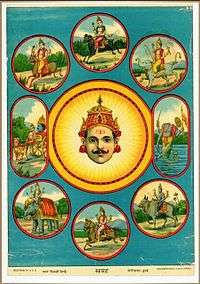Navagraha
Navagraha are nine heavenly bodies (as well as deities) that influence human life on Earth in Hinduism and Hindu astrology. The term is derived from nava (Sanskrit: नव "nine") and graha (Sanskrit: ग्रह "planet, seizing, laying hold of, holding").[2]

Navagraha, a Raja Ravi Varma painting (sun at the center)
Planets, celestial bodies and lunar nodes
The Navagraha are:
Carnatic Music
Muthuswami Dikshitar, a Carnatic music composer from southern India composed the Navagraha Kritis in praise of the nine planets.[3] Each song is a prayer to one of the nine planets. The sahitya (lyrics) of the songs reflect a profound knowledge of the mantra and jyotisha sastras.
gollark: Although this really seems less clear than, say,```javascript-nodefor (let i = 0; i <= 10; i++) console.log(i)console.log("finish")```
gollark: Sorry, this is utterly incomprehensible to my feeble JS-using mind.
gollark: Assembly is functional because you can define functions in it.
gollark: Idea: replace LGBT+ with some sort of regex golf thing?
gollark: Hmm, what if 10x esolang based around... decimal number manipulation?
See also
Notes
| Wikimedia Commons has media related to Navagraha. |
- Sanskrit-English Dictionary by Monier-Williams, 1899
- "Dikshitar: Navagraha". www.medieval.org. Retrieved 2020-06-12.
This article is issued from Wikipedia. The text is licensed under Creative Commons - Attribution - Sharealike. Additional terms may apply for the media files.
